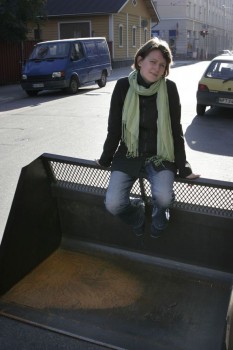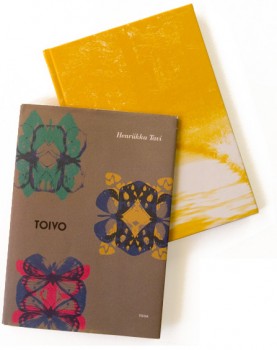The balance of grief
19 December 2011 | Authors, Reviews

Henriikka Tavi. Photograph: Heini Lehväslaiho
In recent years volumes of contemporary Finnish poetry have offered readers the chance to enjoy excellent cover artwork. Right down to the typographical layout, the visual aspects of recently published volumes of poetry – by small and large publishers alike – have turned these books into highly refined, almost holistic works of art.
In such a way the poetics of the language and, in particular, the thematic starting point of the poems are lent a platform that both enhances and strengthens them.
Decorated with images of butterflies, the mournful grey jacket sleeve of Toivo (‘Hope’, Teos 2011), the third volume of poetry by Henriikka Tavi (born 1978), conceals the book’s bright yellow covers and an illuminated woodland path winding its way across them.
In this way the troubled central theme of this multi-disciplinary, collage-style work is immediately reflected in Camilla Pentti’s cover design.
Tavi is one of the most significant poets of her generation. Her debut collection Esim. Esa (‘Esa, for ex.’, 2007) represented a fanciful fusion of the Finnish language and the latest ideas in experimental poetry, a veritable tutti frutti. In her second collection Sanakirja ‘(Dictionary’), she explored the expressive possibilities of different languages juxtaposed with one another. This time she continues her exploration of the language of emotion – her mother tongue – and in Toivo she extracts a variety of extremely beautiful, rhythmical and typographical potential from the core of the language itself.
The principle inspiration for Toivo is the Danish poet Inger Christensen (1935–2009), perhaps the most influential experimental poet of her generation. Like Toivo, her collection Sommerfugledalen (‘The butterfly valley’) brings together the dual themes of grief and longing with childhood memories and the poetic landscape of a summer meadow filled with butterflies. Both poets explore the process of metamorphosis through the metaphor of flying insects: the life span of hungry grubs, coffin-like pupae and the stunning beauty of butterflies.

Cover design of Toivo: Camilla Pentti
A variation of sonnet form, Christensen’s collection receives its own homage in Tavi’s work: Toivo begins and ends with a four-strophe, sixteen-line ‘Lullaby’. The words of these lullabies are a rhythmic, resonant list of butterflies and moths. A translation of these lullabies may be out of the question, but it would appear that the most beautiful Finnish compound names for these insects have here been brought together in song. ‘Sysiyökkönen, synkkänopsa, / kuutäplä, kiertokiitäjä, / kiiltoyökkönen, kirjovaski, / lyijysuomu, kilpiruuni’….
Henriikka Tavi writes about generations – grandparents, parents and children – and the areas of sorrow and hope that exist between them, the grey areas that it usually takes a lifetime to process fully. These winged lullabies sensitively expand the boundaries of interpretation into a series of pupa cradles and metamorphoses.
‘The symmetry of grief’ is one of Christensen’s recurring butterfly metaphors; Tavi translates this as ‘the balance of grief’. This symmetry is represented in the stunning colours of the Mourning Cloak or the Red Admiral: bright colours against a dark, velvet background and vice versa. In these terms, some may think this too aesthetic a starting point for a collection of poetry, but the author of Hope is serious. She turns into verses and strophes two-page stories or death, of people who have departed more or less of their own accord, of the years of their births and deaths. Suicide represents the lack of hope, the abortion of life, the breaking open of the pupa cradle before the metamorphosis is complete.
‘I do not write / to air our family’s business to all and sundry. / Let me / say this as clearly as possible: / You died in vain.’ Here the poet addresses all those who have died ‘in vain’ and one figure in particular, someone whom we might interpret as a father. The poet is also like a young migratory salmon on its way towards the sea, a place where its past and future can become one. She wants to make the lost visible: ‘I’m trying to put a spark in you. / I’m writing so that you’ll come and visit / me. I remember things so little.’
Writing, making pictures, art – all these bring into view things that would otherwise be left unexpressed: ‘Take a photograph of me, one that records my fatigue. As a legacy I’ll leave you a leaking rowing boat, the unfinished renovations and innumerable hours of missed sleep.’ The poet peers towards the closest relationships she remembers as a child, memories that now remain so distant. ‘In the shadow of our own dusk, anything can be shaped once again,’ she says and by the very act of writing enters into a series of metamorphoses spanning from one generation to the next.
Where, therefore, is there room for human hope in poems that so wholly inhabit the valley of sorrow? The collection responds to this question by dropping in the full abundance of the poet’s sense of language. The dark background sucks in the bright stripes in the collage of dialect poems, rhymes, stories in the style of recited folk songs – anything that come close to the reader. Tavi revives the intimacy of speech and locality in poems entitled ‘shavings’, including her grandmother’s memories of childhood written in an endearing, touching vernacular.
The brightness of the thematic figure in the collage that makes up Toivo is open to all; it leaves ample room for interpretation and appeals, shamelessly, to the reader’s emotions.
Translated by David Hackston
1 comment:
Trackbacks/Pingbacks:
-
» Young Finnish Poetry : an approach
20 February 2014 on 5:12 pm[…] Henriikka Tavi has been shaping Poesia since its inception. In 2007 she has won the Helsinki Sanomat Literature Prize for her debut Esim. Esa published at Teos. A short essay about her can be found on Books from Finland. […]
Leave a comment
Also by Mervi Kantokorpi
Finding a voice - 13 November 2014
In the shadow of the cathedral - 6 November 2014
Updated, alive - 8 May 2014
Human destinies - 7 February 2014
Writing silence - 6 June 2013
-
About the writer
Mervi Kantokorpi is a literary scholar and critic and reviews books for, among other publications, the newspaper Helsingin Sanomat.
© Writers and translators. Anyone wishing to make use of material published on this website should apply to the Editors.

16 March 2012 on 6:44 pm
Dear M/S Henriikka Tavi ,
It’s difficult to express in words my joy at your winning the Dancing Bear Poetry Prize for your new collection , Toivo ( ‘ Hope ‘ , Teos )
Please accept my heartiest congratulations on this glorious achievement. In fact , the prize has not come as a surprise because I know that you are distinguished poetess . Hope this is just the beginning and many such prizes will follow you .
My best wishes for a distinguished and bright future.
With regards,
Yours sincerely,
Nihad A. Rasheed
Novelist , translator , and free-lance journalist